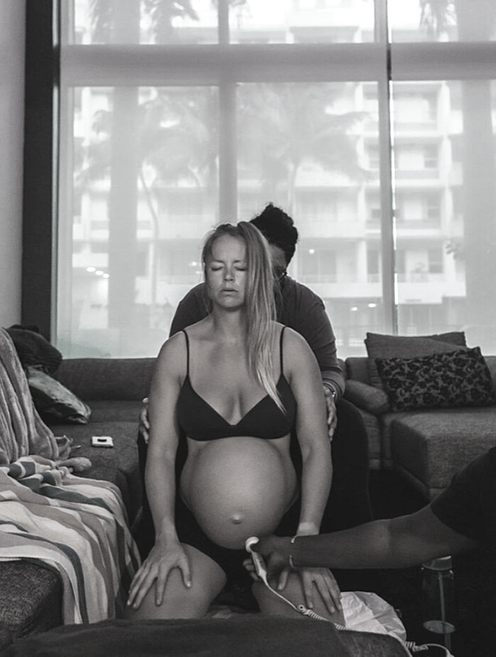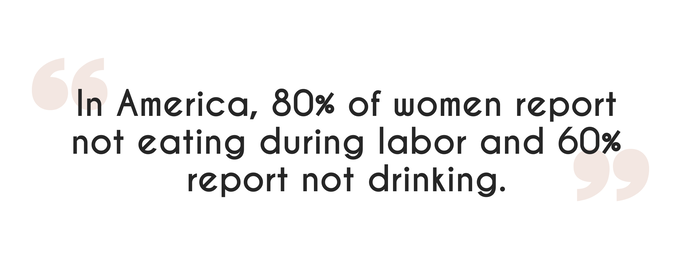 Labor is called labor for a reason. It is hard work. Not necessarily work that you have to put in as it happens involuntarily, but your body and the wondrous organ that is the uterus is working really hard during labor to get the baby in the right position and to push it out of your body. Hard work requires energy and that is where food and drink comes in! Have you ever wondered why many hospitals do not allow eating or drinking during labor? This overwhelming trend in hospital “policy” is for fear of aspiration (throwing up and choking on it) if general anesthesia (getting “knocked-out” and intubated) is needed. This started in the 1940’s when the drugs and tools used while providing anesthesia were very different. Luckily the field of anesthesia has drastically improved, making the probability of aspiration extremely rare. Some hospitals are heeding the newer research and changing their policies for low-risk pregnancies.
Many women feel that they could use a little nourishment, especially during long labors. Some women report no desire to eat during labor, especially as it intensifies. In quick labors there may not be time for it. Your body. Your taste. Your choice. If it is early labor, by all means, eat a well-rounded, nutritious meal until satisfied. Heavy meals are sometimes later regretted. Here are some food ideas that I have found laboring people like:
If you ate during labor, what were your foods of choice? When is a pregnancy no longer low-risk and fasting is recommended? Planned c-section. There are also some other potential factors that might increase your chances of aspiration such as: airway issues, eclampsia, pre-eclampsia, obesity, or opioids in your IV, but they haven’t been thoroughly studied. An epidural does not take you out of the low-risk category, but waiting a while after it is placed to make sure it doesn’t cause nausea is advised. Compare the eating policies at the local hospitals by downloading the Nashville Birthplace Comparison Guide. Sources // Evidence Based Birth
0 Comments
 Image via Instagram: @mintandcocoaphoto Image via Instagram: @mintandcocoaphoto The environment of your birth space truly sets the tone for your birthing experience. First, you should ask yourself, how do I want to feel during birth? Do you want the vibe to be spa-like or a more energetic celebration? There is not a wrong answer to this question. It is totally dependent on your personal preference! Research shows that “Creating an environment that helps women to feel safe and secure during birth can improve women's experiences and likelihood of normal birth.” (Royal College of Midwives, 2014). A “private, undisturbed and dark environment, where women feel calm and safe can promote the release of oxytocin, the hormone responsible for uterine contractions and thought to promote the release of the pain relieving hormones endorphins” (Uvnas Moberg, 2003). When this environment is “not achieved, women can experience fear-tension-pain syndrome, impending labour progress and causing increased levels of pain” (Dick-Read, 2013). Here are some tips for creating a calm, spa-like environment in a hospital: During labor and birth, focus and composure are both very important. You may not think of things like beeping, talking, or a subtle hum of a machine as distracting until you are trying to coax a tiny human out of your body 🙂 The 615 Doula Co Approach Little things such as the vibe of your birthing environment might seem tiny in the overall birth plan, but trust me, these details are so significant in the moment. As your doula, I help walk you and/or your family through your birth space desires. We create a step-by-step plan on how we are going to achieve the vibe you want and uphold it in the actual labor space. Sources // Royal College of Midwives, Uvnas Moberg, Dick-Read, National Library of Medicine  We grow up hearing birth stories and so many of them are not positive. The moment you tell someone you are pregnant, they share a birth story. These stories shape our view of birth, often negatively. A big part of preparing for birth is redefining perceptions. Affirmations are one tool we can use to reset our perceptions around birth. Most of us use affirmations in our daily life, though not always intentionally or positively. We often say or think negative or limiting thoughts, especially about birth. For instance, “I’m sure something is going to go wrong.”; “We don’t know what we are doing.”; “I’ll probably end up with a c-section.” etc. The goal of setting intentional, positive affirmations is to reinforce your vision for your birth and mitigate negative thoughts. They are part of the internal work we can do to prepare for a powerful birth. They are an opportunity to build your internal connections and show yourself (and your baby) loving support. Affirmations do not guarantee that you will have a specific type of birth, but they are helpful in shifting mindsets to ones of empowerment and love, instead of fear. Steps:
Sample Affirmations:
|
Meet Nicki
Hi, I'm Nicki! I am a Nashville based Doula and founder of 615 Doula Co! My favorite part of working as a Doula is supporting families through the life transitions of pregnancy, birth, and postpartum life. Explore Blog |







